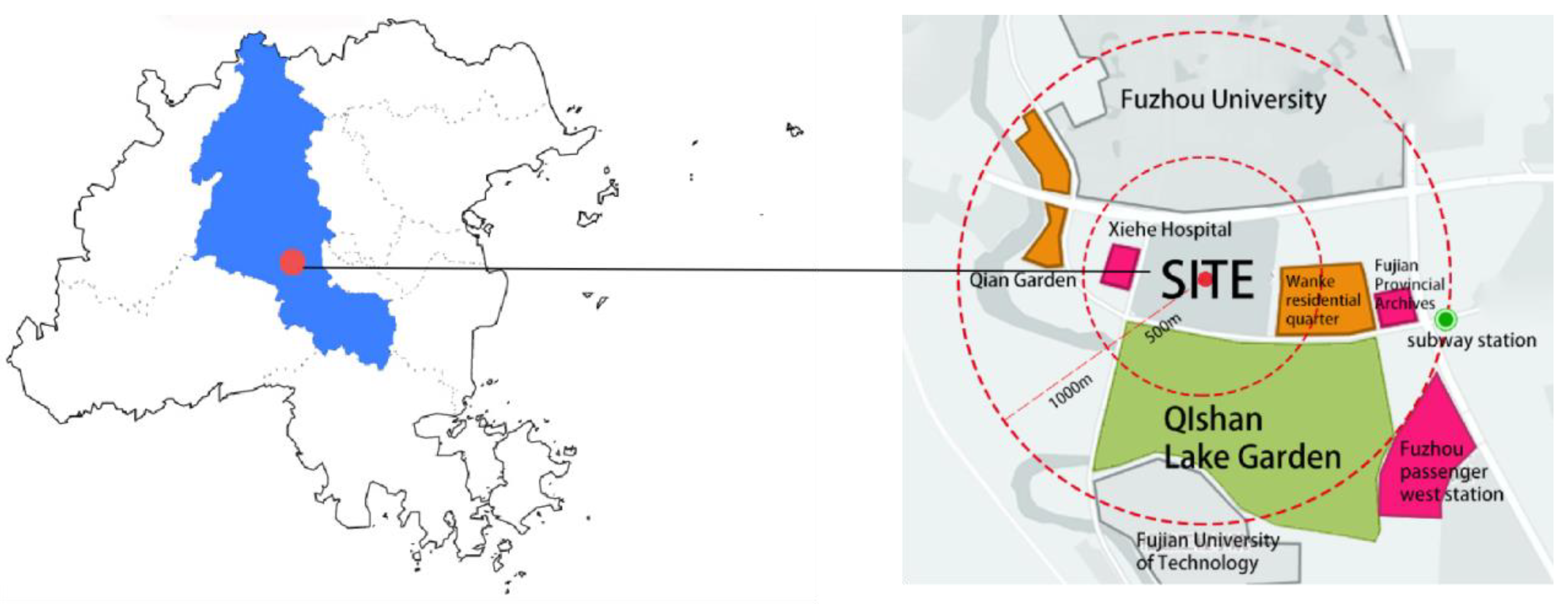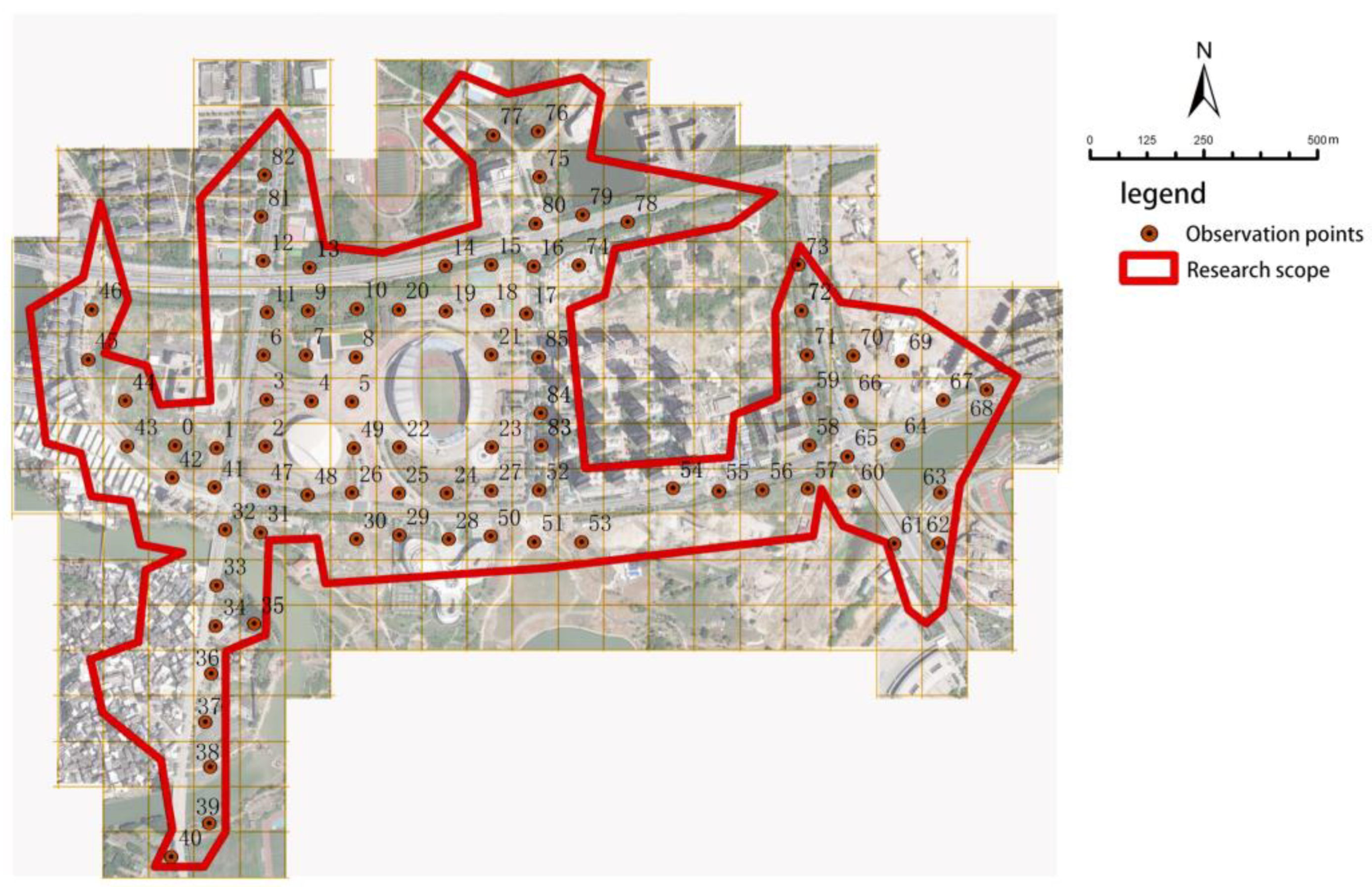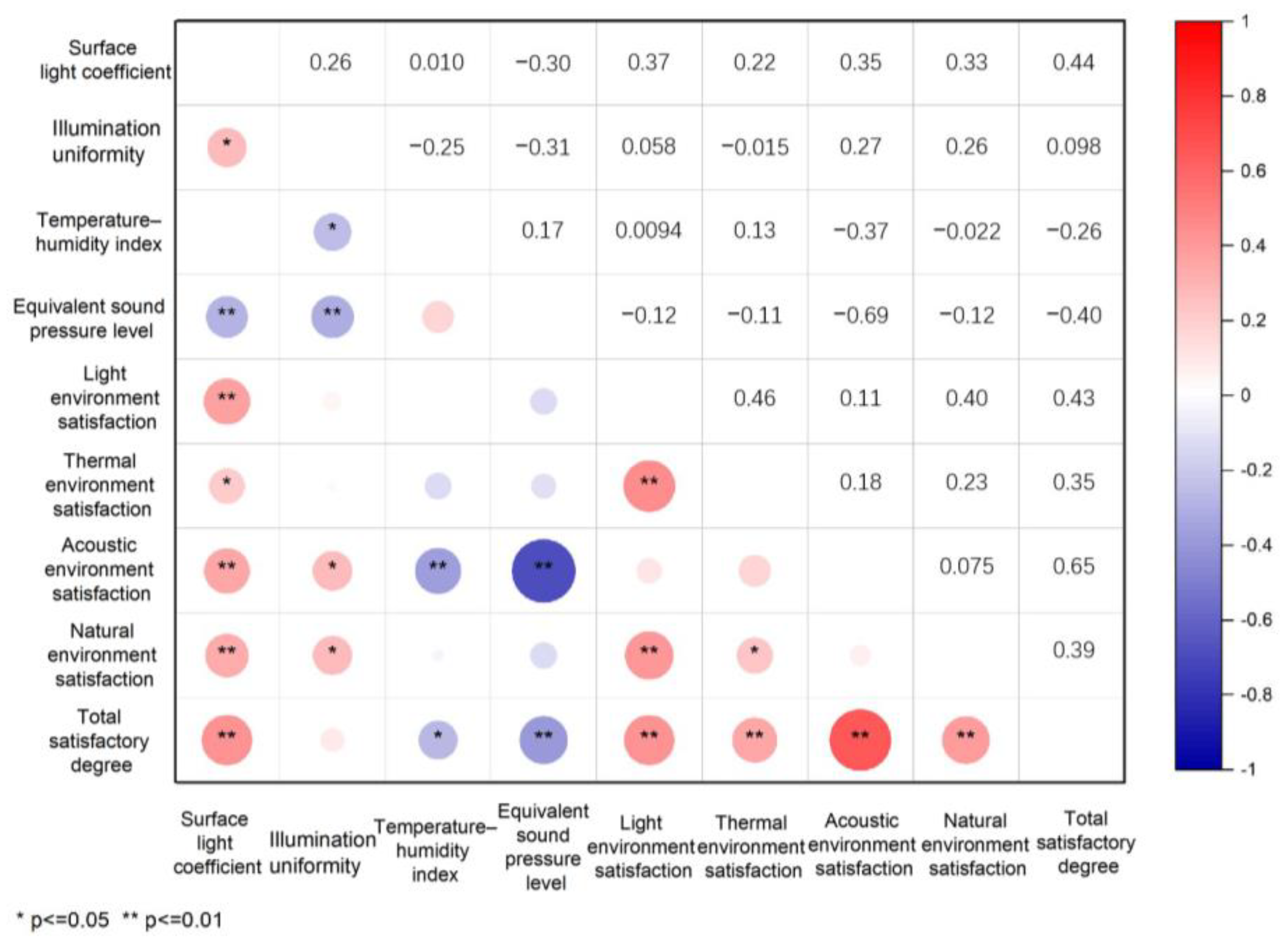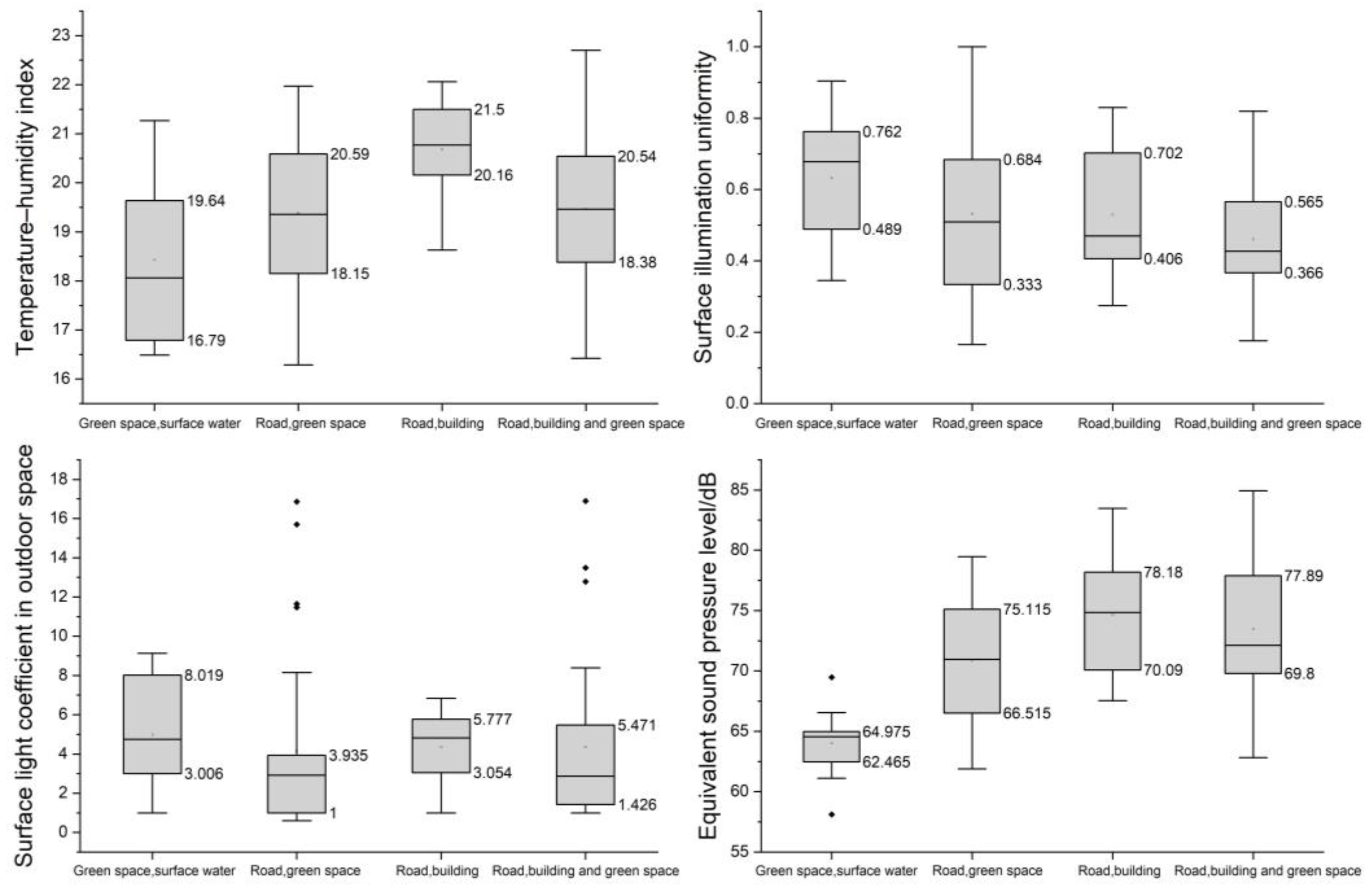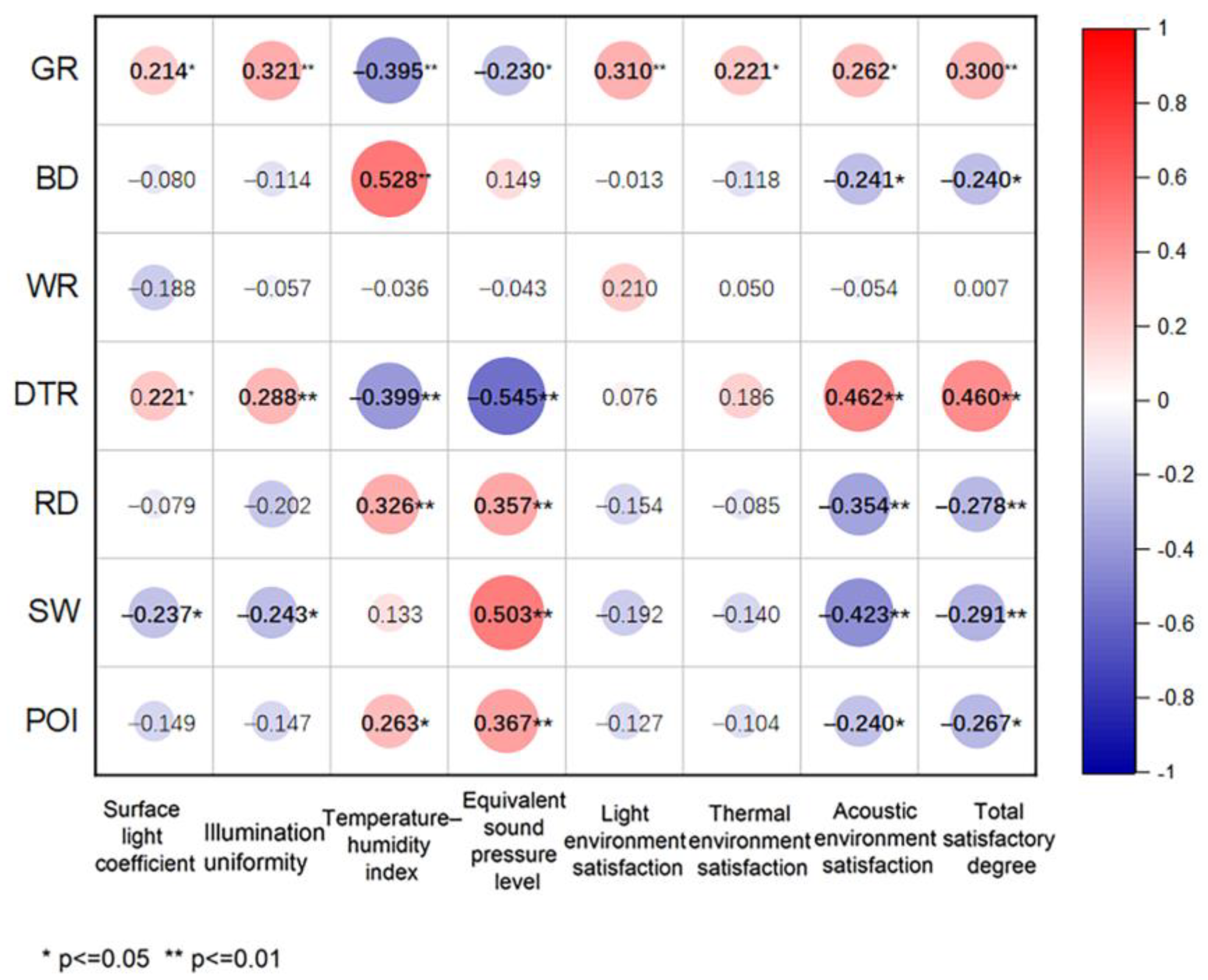1. Introduction
The urbanization process in China is currently experiencing a rapid development. However, this process has resulted in high-intensity development and rapid expansion that have significantly impacted the urban environment. This has triggered a series of urban diseases, such as the heat island effect, noise pollution, light pollution, air pollution, etc., which have seriously reduced the quality of the urban living environment. Multiple studies have focused on the elements of thermal, acoustic and light environments in urban areas, which indicate that poor urban physical environments can have a significant negative impact on people’s physiological and mental health [
1,
2]. For instance, urban noise exposure may cause annoying moods and insomnia, increasing the probabilities of hypertension and cardiovascular disease, as well as negative effects on the auditory and nervous systems [
3]. The urban thermal environment also poses a significant risk factor for death and related diseases in the population, especially cardiovascular and respiratory diseases, during heat waves [
4,
5]. Furthermore, the light environment directly affects not only the ambience of public spaces, but also people’s behavior, sleep and mood [
6]. These urban physical environments potentially influence public health in communities.
A community living circle is the basic constituent unit of urban space where most daily activities occur. In contrast to traditional communities, campus cities should integrate the campus, community and industrial areas in a symbiotic and complementary way. Communities are an extension of commerce, residence and education within universities in the campus city, enriching the spatial pattern of the university town and promoting diversified development from traditional teaching spaces. At the same time, with the popularization of the concept of a “shared campus” and “shared community”, sharing public facilities between campus city communities and universities has become an inevitable trend [
7]. The sharing of sports facilities and resources has brought great convenience to the community. The Fuzhou city campus is rich in sports facility resources, and can serve social services and radiate sports activities of surrounding residents. It can also provide a sharing platform for staff and college students to effectively use venue resources and participate in sports activities. The outbreak of the COVID-19 pandemic changed public recreational and commercial activities in community living circles. During the pandemic period, residents’ need for fitness and leisure increased, and sports facilities in university town communities became important public activity places for community residents, college teachers and students.
Against this backdrop, it is indispensable to provide suitable community utility services in community life circles, especially in emergency quarantines, contributing to building an urban organic system of healthy cities in terms of a healthy environment and a healthy society [
8]. The quality indicators of a healthy city are derived from both the objective aspect, such as the average regional environmental noise, the land area of sports facilities per capita and greening coverage, and the subjective aspect, such as satisfaction with environmental quality [
9].
This requires high-quality community public facilities to meet the needs of residents for their daily activities. Public activity spaces are a complex environment containing many factors, among which physical factors, such as the thermal environment [
10], acoustic environment [
11], visual environment, etc., can affect individual perception [
12]; other factors can also affect individual perception, and can affect one another, influencing people’s perception of the overall environment. Different factors jointly affect the physical environment, and many studies have focused on the relationship between physical environmental factors and environmental comfort, conducting research on thermal comfort and acoustic comfort [
13,
14]. A large body of research has also focused on the effects of noise and its sound pressure levels on individual thermal perception. Some scholars used the temperature and noise sound pressure level (SPL) in different durations to explore the subjective effects of the acoustic environment and thermal environment on people [
15]. Some scholars also used the equivalent continuous sound pressure level (Leq) to study the relationship between the background soundscape and thermal environment, finding that noise is an important factor affecting thermal perception [
16]. In a study of the perception of the visual environment, visual factors mainly included the surface materials, shadows and lights of buildings or roads [
17,
18]. Some scholars found that under different thermal environment conditions, solar light illumination (LUX) had a crossmodal effect on thermal sensation, which could alleviate the thermal discomfort in outdoor public spaces by improving visual comfort [
19]. Therefore, public facilities, as important activity spaces of community life circles, should take environmental comfort as a necessary condition for outdoor activities, and comprehensively consider the influence of acoustic, light, thermal and other factors.
Notably, sports facilities are one of the most important types of public facilities in campus city community life circle, contributing benefits to physical fitness, the residents’ health status, the efficiency of operations and buying inclination [
20]. Plenty of studies have paid attention to the environments around urban stadiums, having become a topic of interest [
21,
22,
23]. A previous piece of research explored the relationship between reverberation time, activity noise levels and human comfort in the acoustic environment of a stadium [
1]. In addition, the typical thermal environment of a university gymnasium was effectively simulated based on the thermal building layout, building orientation, natural lighting and ventilation [
24]. The gymnasium building form may affect thermal comfort in subtropical humid and hot regions, especially in summer [
25]. Furthermore, internal relationships may exist among natural light, stadiums and visitor behavior from a combined subjective and objective perspective [
26]. However, there is a lack of the comprehensive consideration of acoustic, light and thermal environments and the visualization of psychophysical spatial distribution in stadiums in community living circles.
Thus, this study was conducted to fill the above gaps, aiming to: (1) explore the data interval for the best-perceived effects of environmental elements in the study area; (2) observe psychophysical relationships between acoustic, light and thermal environments; (3) and visualize the psychophysical drivers influencing spatial distribution through the use of a geographic information system (GIS).
4. Discussion
The acoustic, light and thermal environment physical indicators in the urban environment affected the psychological feelings of respondents. In the overall environmental satisfaction evaluation, the equivalent sound pressure level, the greenhouse index and the external space surface light coefficient together affected the overall environmental satisfaction evaluation, with the external space surface light coefficient having the largest proportion, followed by the equivalent sound pressure level, which was mainly affected by road traffic noise pollution in this study.
Roads as potential drivers contributed to high L
Aeq levels in the western and eastern parts of the study areas located along Metro Line 2 in the southeast, which contained denser residential areas and construction sites with negative auditory perception. There were low L
Aeq areas near the campuses, parks and sports centers, which were less affected by road noise and had high subjective scores. Building density and POI facility points contributed to an increase in human and vehicle traffic, especially around public service facilities in the community living circle. Additionally, various activity sounds intertwined with natural sounds and peripheral traffic sounds to perform various rhythmic soundscapes [
32,
33,
34]. Natural sounds, such as flowing water, wind, vegetation movement and birdsong were positive drivers influencing human perception, while human-generated activity sounds and traffic sounds were negative drivers [
35]. We observed correlations between spatial and psychophysical drivers. DTR and GR positively correlated with the satisfaction of the acoustic environment, suggesting that the experience of the acoustic environment significantly improved when the public was away from road noise, and the area with a larger proportion of green space was less influenced by traffic, with green space having a certain barrier effect on traffic noise [
36]. Our findings suggested the proportion of natural and biological sounds in green space was high, and that of artificial sound was low, contributing to improving the auditory experience. In urban green spaces, increasing natural soundscapes and reducing traffic noise could improve auditory satisfaction and levels of human health [
37,
38]. Previous research suggests that these positive effects of urban green spaces are directly related to the objective reduction in noise levels to the subjective perception of noise exposure [
39]. Furthermore, the results suggested a significant correlation with POI points, where dense service points were also accompanied by greater crowd density, generating a concomitant increase in the proportion of activity and traffic sound.
Our findings suggested that the temperature–humidity index showed higher values close to roads with low greenery and high building densities, and a high percentage of green spaces and water bodies contributed lower values. Plant elements, such as trees, shrubs and turf, had a shading effect on the public spaces, contributing to reducing direct sunlight and external heat reflection through plant transpiration and improving the surrounding microclimate. There was a positive effect of building density on surface temperature in high-density urban built-up areas on the thermal environment, contributing to environmental warming [
40,
41]. This suggested a need for a certain increase in green space ratio to improve vegetation transpiration capacity and to enhance local convection, contributing to reducing the temperature–humidity index [
42]. Road density levels were positively correlated with the average road temperature [
43].
In the urbanization process, urban green spaces with low surface temperatures were transformed into other land use types with high surface temperatures, thus, negatively affecting the urban thermal environment [
44,
45]. The design of green spaces should be fully considered in the design of urban public facility spaces to mitigate the thermal environment problems. Our findings suggested a positive correlation between POI points and the temperature–humidity index because most of the POI points were for commercial services and public facilities, with high values in terms of building density and road density. Previous research suggests that areas of commercial buildings and alleys are important drivers for the increase in surface temperature [
46]. In addition, dense POI points contributes to high temperature–humidity indexes.
Furthermore, the results suggested a high correlation between the light and thermal environments, both of which correlated with the spatial elements of green spaces. Landscape elements, such as vegetation configuration and the vignette arrangement of green spaces, improved the visual experience and microclimate, contributing to improving the satisfaction of the light environment. Previous research suggested that relevant elements of green spaces positively influence the subjective evaluation of human audiovisuals, and audiovisual satisfaction increased when the share of green-related elements was higher than that of traffic-related elements [
47]. Considering warm winters and cool summers for climate characteristics of Fuzhou, the shading effect of green spaces plays a positive role in light and thermal environments. Therefore, the design and planning of green spaces should be considered in the construction of the physical environment of public facilities in Fuzhou. Suitable design and planning could contribute to improving the physical environment comfort, enhancing the efficiency of operations and vitality of business forms.
5. Conclusions
We used subjective questionnaires and objective physical measures to determine the effect of spatial forms on psychophysical perception. Spatial forms affected psychophysical drivers in the community life circle. The physical indicators of the acoustic, light and thermal environments in the urban environment affected the psychological feelings of the respondents. Our findings showed that: (1) The acoustic, light and thermal environments had an impact on overall environmental perception. The light coefficient, LAeq and temperature–humidity index were important environmental indicators that affected the overall environmental satisfaction. (2) The LAeq and temperature–humidity index of roads and construction land were opposite to those of green spaces and water bodies. (3) Green spaces played a positive role in the satisfaction of acoustic, light and thermal environments. (4) The density of roads, buildings and POIs played a negative role on satisfaction with the acoustic environment. (5) Green spaces and street width potentially influenced the light coefficient and surface illumination uniformity.
Our findings contribute to the basic data of urban public facilities and spatial physical environment evaluations. Exploring the impact of spatial factors on the psychophysical environment allowed us to understand which design elements in urban planning can provide higher comfort in public spaces and develop suitable suggestions for low-carbon planning and industrial distribution in urban areas. In addition to the acoustic, light and thermal environments, the comfort and satisfaction of community public spaces were also affected by other factors, including physiology, social culture, behavior, etc. The driving role of more factors on the psychophysical environment should be considered comprehensively in future studies.
